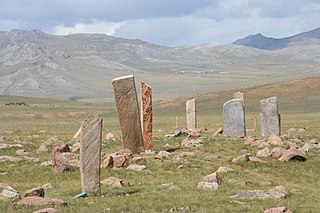
Siberia is an extensive geographical region comprising all of North Asia, from the Ural Mountains in the west to the Pacific Ocean in the east. It has formed part of the sovereign territory of Russia and its various predecessor states since the centuries-long conquest of Siberia, which began with the fall of the Khanate of Sibir in the late 16th century and concluded with the annexation of Chukotka in 1778. Siberia is vast and sparsely populated, covering an area of over 13.1 million square kilometres (5,100,000 sq mi), but home to only one-fifth of Russia's population. Novosibirsk, Omsk, and Chelyabinsk are the largest cities in the area.

Nyx is the Greek goddess and personification of night. A shadowy figure, Nyx stood at or near the beginning of creation and mothered other personified deities, such as Hypnos (Sleep) and Thanatos (Death), with Erebus (Darkness). She is the first child of Chaos. She is typically portrayed as either a winged goddess with a dark cloud halo or dressed in black surrounded by dark mist. Her Roman equivalent is Nox.

The Russian Far East is a region in Northeast Asia. It is the easternmost part of Russia and the Asian continent; and is administered as part of the Far Eastern Federal District, which is located between Lake Baikal in eastern Siberia and the Pacific Ocean. The area's largest city is Khabarovsk, followed by Vladivostok. The region shares land borders with the countries of Mongolia, China, and North Korea to its south, as well as maritime boundaries with Japan to its southeast, and with the United States along the Bering Strait to its northeast.

The little owl, also known as the owl of Athena or owl of Minerva, is a bird that inhabits much of the temperate and warmer parts of Europe, the Palearctic east to Korea, and North Africa. It was introduced into Britain at the end of the 19th century and into the South Island of New Zealand in the early 20th century.

The willow warbler is a very common and widespread leaf warbler which breeds throughout northern and temperate Europe and the Palearctic, from Ireland east to the Anadyr River basin in eastern Siberia. It is strongly migratory, with almost all of the population wintering in sub-Saharan Africa.

The Eurasian or common whimbrel, also known as the white-rumped whimbrel in North America, is a wader in the large family Scolopacidae. It is one of the most widespread of the curlews, breeding across much of subarctic Asia and Europe as far south as Scotland. This species and the Hudsonian whimbrel have recently been split, although some taxonomic authorities still consider them to be conspecific.

The grey partridge, also known as the gray-legged partridge, English partridge, Hungarian partridge, or hun, is a gamebird in the pheasant family Phasianidae of the order Galliformes, gallinaceous birds. The scientific name is the Latin for "partridge", and is itself derived from Ancient Greek perdix.

The spotted flycatcher is a small passerine bird in the Old World flycatcher family. It breeds in most of Europe and in the Palearctic to Siberia, and is migratory, wintering in Africa and south western Asia. It is declining in parts of its range.

The common reed bunting is a passerine bird in the bunting family Emberizidae, a group now separated by most modern authors from the finches, Fringillidae. The genus name Emberiza is from Old German Embritz, a bunting. The specific schoeniclus is from Ancient Greek skhoiniklos, a now unknown waterside bird.

The Eurasian bullfinch, common bullfinch or bullfinch is a small passerine bird in the finch family, Fringillidae. In Anglophone Europe it is known simply as the bullfinch, as it is the original bird to bear the name bullfinch.

The boreal owl or Tengmalm's owl is a small owl in the "true owl" family Strigidae. It is known as the boreal owl in North America and as Tengmalm's owl in Europe after Swedish naturalist Peter Gustaf Tengmalm or, more rarely, Richardson's owl after Sir John Richardson.

Lama, Lamma, or Lamassu is an Assyrian protective deity.

In Greek mythology, a little owl traditionally represents or accompanies Athena, the virgin goddess of wisdom, or Minerva, her syncretic incarnation in Roman mythology. Because of such association, the bird—often referred to as the "owl of Athena" or the "owl of Minerva"—has been used as a symbol of knowledge, wisdom, perspicacity and erudition throughout the Western world.

The Markandeya Purana is a Sanskrit text of Hinduism, and one of the eighteen major Puranas. The text's title Markandeya refers to a sage in Hindu History, who is the central character in two legends, one linked to Shiva and other to Vishnu. The Markandeya text is one of the Puranas that lacks a sectarian presentation of ideas in favor of any particular god, and it is rare to read any deity being invoked or deity prayers in the entire text.

Deer stones are ancient megaliths carved with symbols found largely in Siberia and Mongolia. The name comes from their carved depictions of flying deer. There are many theories to the reasons behind their existence and the people who made them.
The spirit spouse is a widespread element of shamanism, distributed through all continents and at all cultural levels. Often, these spirit husbands/wives are seen as the primary helping spirits of the shaman, who assist them in their work, and help them gain power in the world of spirit. The relationships shamans have with their spirit spouses may be expressed in romantic, sexual, or purely symbolic ways, and may include gender transformation as a part of correctly pairing with their "spouse". Shamans report engaging with their spirit spouses through dreams, trance, and other ritual elements. In some cultures, gaining a spirit spouse is a necessary and expected part of initiation into becoming a shaman. Examples of spirit spouses may be seen in non-shamanic cultures as well, including dreams about Jesus Christ by nuns, who are considered to be "brides of Christ".

Permian bronze casts – Permic and Western Siberian animal style cult cast figurines – were the predominant form of Finnic toreutics of the 3rd–12th centuries CE. It was spread throughout a large area of forests of the north-eastern Urals and western Siberia from the basins of the Kama and Vyatka to the Ob. In the Middle Ages, these territories were inhabited mostly by the Ugrian tribes, ancestors of the present day Hungarians and Ob-Ugrians – the Khanty and the Mansi people. Their style is referred to as the "Permian animal style".

The state of Punjab is renowned for its cuisine, culture and history. Punjab has a vast public transportation and communication network.
In Greek and Roman mythology, Peristera is a nymph who was transformed into a dove, one of Aphrodite's sacred birds and symbols, explaining the bird's connection to the goddess. This myth survives in the works of the first of the three anonymous Vatican Mythographers, whose works were discovered in a single manuscript in 1401.
















